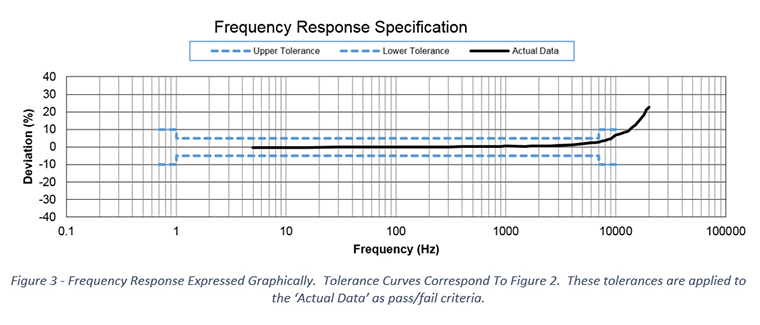Main Menu
- Home
- Product Finder
- Calibration Systems
- Calibration Services
- Digital Sensing
- Industrial Vibration Calibration
- Modal and Vibration Testing
- Non-Destructive Testing
- Sound & Vibration Rental Program
- Learn
- About Us
- Contact Us
Have you ever found yourself in a lengthy calibration-related conversation? With details such as specifications, in tolerance/out of tolerance status and uncertainties being discussed? Chances are that you have ended up using “percentage difference” or “deviation” several times and often in a few different contexts. This month we will explore some of the confusion in percentages.
Two of the most commonly discussed accelerometer specifications are sensitivity and frequency response. Both of these specifications are expressed using a percentage, both are common failure modes for an accelerometer, and both are checked as part of an ISO 16063-21 calibration test of an accelerometer. As a result of this commonality, they are also frequently the source of confusion when discussing accelerometer calibration results.
Accelerometer sensitivity is the ratio of electrical output to acceleration input. It is often expressed in any of the following ways:

In each of the expressions above, the numerator (the top of each ratio) is an electrical measurement expressed as some form of voltage or amperage. In each of the denominators (the bottom of each ratio) is a mechanical measurement of acceleration.

Consider the image below from an accelerometer specification sheet for sensitivity. This specifies that the measured accelerometer sensitivity must fall within ±5% of a nominal value of 10 mV/g. In this case, the percentage is a tolerance referenced to the design target for the accelerometer.
It is interesting to note that the nominal sensitivity is measured at a frequency we call the reference frequency[1]. In the example above, the sensitivity of the accelerometer must fall between 9.5 and 10.5 mV/g to be within manufacturer's tolerance.
As mentioned directly above, the sensitivity of an accelerometer is specified at a "reference frequency." This, by itself, is sufficient if the user is interested in measuring acceleration that happens to occur at the reference frequency. Of course, we know that accelerometers are used to measure acceleration over a broad range of frequencies and the sensitivity changes over these frequencies. "Frequency Response" specifies the uniformity of the accelerometer output over a broad range of frequencies. In this case, the tolerance is referenced to the measured sensitivity at the reference frequency. For the accelerometer in Figure 2, the sensitivity from 1 Hz to 7000 Hz will be within ±5% of the measured value at the reference frequency. These parameters are highlighted in red.

This uniformity is also specified with a wider (±10%) tolerance over a wider frequency range (highlighted in green). Figure 3 graphically represents the information tabulated in Figure 2.
 So while these percentages, if used interchangeably in conversation, may introduce confusion
to a conversation, they are used to successively describe accelerometer output with more and more specificity. In the vaguest description, we refer to the nominal, or designed sensitivity, of an accelerometer and specify the allowable percent deviation
from it for the measured sensitivity at the reference frequency. Furthermore, we use the percent deviation for frequency response to specify the allowable deviation at any frequency, referenced to the measured sensitivity at the reference frequency.
So while these percentages, if used interchangeably in conversation, may introduce confusion
to a conversation, they are used to successively describe accelerometer output with more and more specificity. In the vaguest description, we refer to the nominal, or designed sensitivity, of an accelerometer and specify the allowable percent deviation
from it for the measured sensitivity at the reference frequency. Furthermore, we use the percent deviation for frequency response to specify the allowable deviation at any frequency, referenced to the measured sensitivity at the reference frequency.
Beyond sensor specifications, percentage deviation is often used interchangeably with percentage difference, percentage error, or percent change when comparing two independent frequency response calibrations. The context of the two calibrations is often the determining factor in deciding the verbiage used. For example:
[1] In the U.S., a reference frequency of 100 Hz is used; internationally 159.2 or 160 Hz is used. More details are available from accelerometer manufacturers and your calibration certificate.